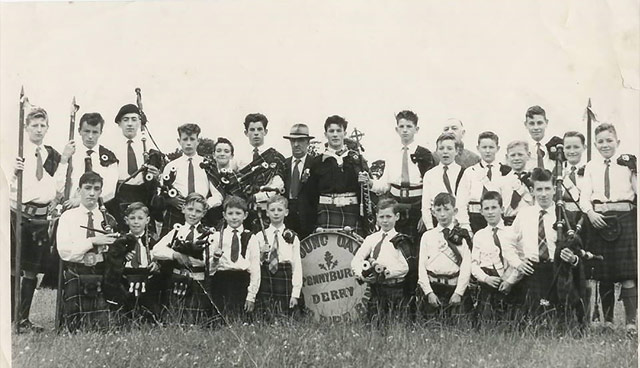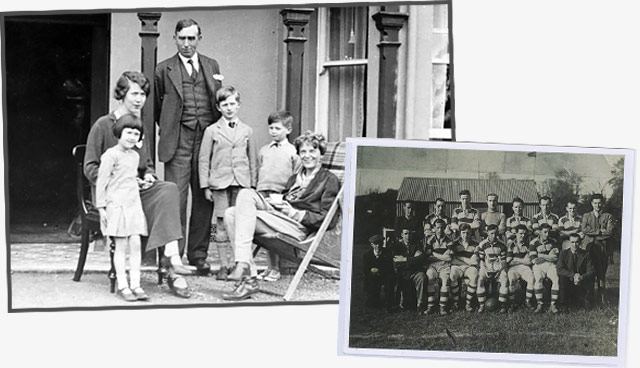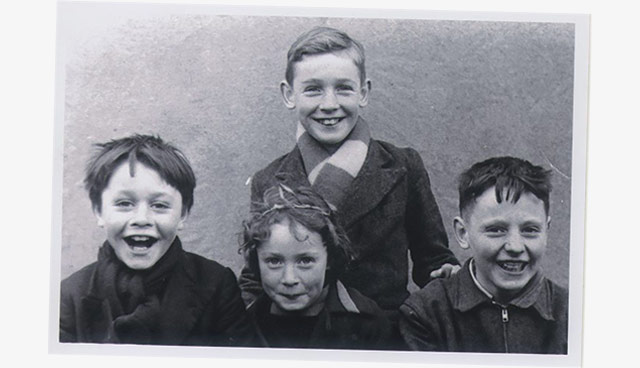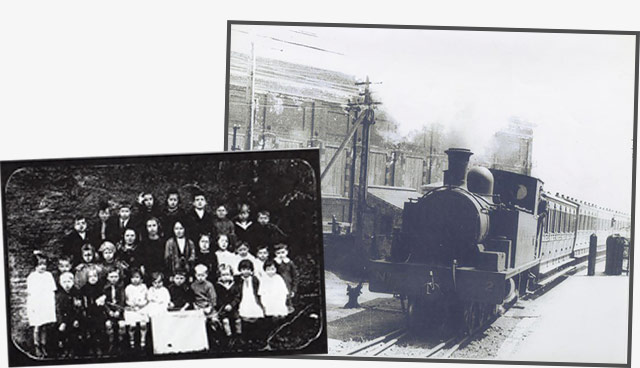Bringing history home: The Forge Writers’ Group


Variously referred to as Sean Talamh (Old Ground), the area between the old urban boundary at the Collon and Donegal border forms an essential part of the North Western landscape. Niall Coleman speaks with the Forge Writers’ Group, who have compiled photographs, memoirs and eyewitness accounts in a bid to document the town of Shantallow’s vibrant local history.
Recent weeks have been demanding for the Forge Writers’ Group. Two years of monthly meetings, hours of oral recordings, dozens of recorded conversations and the building of an extensive archive of material has culminated in the publishing of ‘Between the Collon and the Border: A People’s History of Shantallow’. A group of local historians, writers and heritage enthusiasts, the Forge Writers’ Group has combined efforts with the Greater Shantallow Area Partnership to create a definitive history of Derry’s largest suburb – home to 30,000 of the North West’s population and one of the most controversial land frontiers in modern history.
Overseeing the project is Joseph Martin, a founding member of the Greater Shantallow Area Partnership, the Forge Writers’ Group and co-author of Between the Collon and the Border. For Martin, collating the history of Shantallow has been the natural result of a keen sense of local pride. “We are proud to be from this unique part of the country. We are happy to live here, and we share many happy memories growing up – memories which eventually brought us together as a group around three years ago,” says Martin, reflecting on the history of the place he calls home.
A community transformed
Over 50 years ago, Shantallow was transformed from a rural area with a population of 5,000 people to the heavily built-up suburb of Derry, which is now populated by 40,000 people. Charting that transformation and all of its curiosities has provided ample labour for the group, who have channelled their passion for local history into the creation of a permanent digital archive. “We looked particularly at the 50-year period before the area was transformed. Our local racecourse, based at Ballyarnett, had been a prominent feature of entertainment in the North West for up to 200 years. That was in its final days a century ago, and the years that followed brought with them greater change”.
Indeed, the transformations seen in Ireland’s North West and further afield across Europe were significant: world war, civil conflict, the invention of electricity and the partition of Ireland saw Shantallow undergo a period of unprecedented change. Indeed, the progression of history has been charted by the group through a series of anecdotes, interviews and photographs — an archive now available to future generations of this tightly-knit community.

The Cornshell Landing
Martin draws attention to the world-famous visit of American aviator Amelia Earhart, the first female pilot to cross the Atlantic Ocean — an event now deeply entrenched in local lore. “She was on her way to France and was forced to pause her flight here due to a fuel shortage. We know men and women who have spoken of ancestors who met her that day,” he explains. “According to local legend, a few local men approached Earhart as she landed in nearby fields. She asked the men where she was, and they answered, ‘you are in Cornshell, sir’. She had her suit and goggles on, and they couldn’t believe a woman was piloting the plane. The rest, as they say, is history.”
The next major local event, whilst also involving aircrafts, marked a tragic chapter in the history of the area. At the height of the Blitz, one of the only bombings to occur outside of Belfast exploded in Shantallow, with devastating effect: fourteen civilians, including young children, were killed after a Luftwaffe pilot discharged floating para-mines, destined for the city’s shipyard. Whilst the region was fortunate to have avoided the carnage experienced in the likes of Coventry and London, the event traumatised a generation, leading to the displacement of thousands of Derry citizens into the Irish Free State, many to never return.”
Such disruptive experiences have fostered a hardy and resilient community in the North West, according to the group. “The border of partition came in the early 1920s. It transformed things logistically. There was now a frontier and customs officials to negotiate with. And certainly, locally, smuggling was widespread – we all have memories of it,” reflects Martin, “and as a schoolboy, I recall being sent by my mother to Donegal, where I smuggled balls of wool up my jumper to knit jumpers for the next winter”. Such obstacles had minimal impact on a community who were determined to carry on, ‘business as usual’: “partition didn’t stop us, and neither will Brexit. If the border becomes harder, we will find a way past it, as we always have.”

It is the closely-woven network of relationships that have sustained the community through such change, according to the group. To illustrate that point, Martin highlights the story of a migrating Presbyterian community, who moved into the area from Donegal in the 19th century. “They moved not for political reasons, but because they simply didn’t like the minister they had been given in Donegal. So, they came here, and they set up their community,” he explains. The story is one of many which demonstrates a strong cross-community culture within the region: members of the local Prince of Wales Flute Band regularly exchanged equipment with the Ancient Order of Hibernians in times of need, often sharing drinks together in the local bar following marches. In the present day, the ‘two communities’ of Shantallow have regularly came together, from shared festivities at the City of Culture celebrations, to cross-denominational bowling clubs hosted by Ballyarnett and St. Peter’s churches.
Overcoming adversity has formed an essential part of the North West’s social fabric. “The Greater Shantallow Area Partnership comprises a number of community groups that got together and identified shortfalls in essential provisions, such as play spaces, meeting spaces and men’s health facilities. We got together and enlisted voluntary and statutory efforts in an attempt to make the place a better area to live in. Whilst an event like Brexit would be inconvenient, it will not hold back our border community at all,” states Martin. “Being cut off from our natural hinterland in Donegal has certainly deprived the North West of much of its impetus and action. Our position at the centre of the shirt trade and ship building was changed by the partition of Ireland. However, we can transcend borders and work our way around them. We have lived through poverty, and a different kind of austerity. Surviving through that enabled us to set an example to others,” he adds.
Towards the future
Indeed, setting an example to others has been a core objective of the Forge Writers’ Group. Speaking about the goals of the group, Darren Kirby of the Greater Shantallow Area Partnership spoke of the need to broaden the appeal of history to future generations. “In the approach to the 2013 City of Culture celebrations, we sought to maximise the visitation of suburban areas. Engaging with the public demonstrated that Shantallow was an area rich with stories and heritage, which didn’t feature in the tourism strategy for the area. So, we decided to establish a digital archiving hub which could capture oral histories, photographs and other material that could be kept as a permanent archive for the local area. From that engagement, people asked for more projects. That has led to our heritage app, which will be ready for launch in 2019. We have also been working on a heritage trail for Ballyarnett, which tells the story of the Earhart landing and the history of Shantallow racecourse.”

Showcasing the history of the North West beyond the confines of Derry City has been of particular importance to historian Tom Deeney, author of The History of Ballyarnett Racecourse and the Derry/Londonderry Races (2013) and Bernard Bradley, an expert on the local area. “Having been born close to the racecourse, I thought this was a project worth doing. A lot of the people who have entered the district over the past 20 years weren’t aware of the racecourse, thanks in part to a new build-up which has essentially camouflaged it. The racecourse book was the start of a process, and we are hoping to keep that process going over the next few years. We feel that the area is worth the attention, and my particular opinion is that the history of the area extends beyond the city walls, and we would be keen to add to it”.
Broadening and showcasing local history to the next generation is highlighted as crucial by Mary McBrearty of the Greater Shantallow Area Partnership. “Perhaps, in the future, young people can find new ways of documenting their people. With that in mind, the extended schools programme, funded by the Education Authority, allocated funds to our new, young writers’ group, allowing them to document local history in the form of a comic strip,” explains McBrearty. “We have a local camera club, and The Forge is able to develop pictures at a small price. People have been able to reminisce and see old footage. The young people couldn’t get over the old 8mm cameras, so they really enjoyed that,” she adds.
Bringing history home
Uniting the entire group is a shared passion for the place they were raised in and a desire to see history passed down to future generations. Sean Quinn, group member and co-author of Between the Collon and the Border, suggests that the study and promotion of history is of crucial importance to a healthy society. “The study of history is something which enriches you more in a human sense than it might in a monetary sense, but is no less important for it. History forms part of a humanist education, which lets you dig into how people think and act, and demonstrates the fact that people haven’t changed that much in their attitudes, no matter how far you go. It’s important as it teaches you how to think about other people. That is particularly relevant in Northern Ireland with Brexit, the legacy of the past and the rise of the far right. We could do with more understanding in today’s world.”





